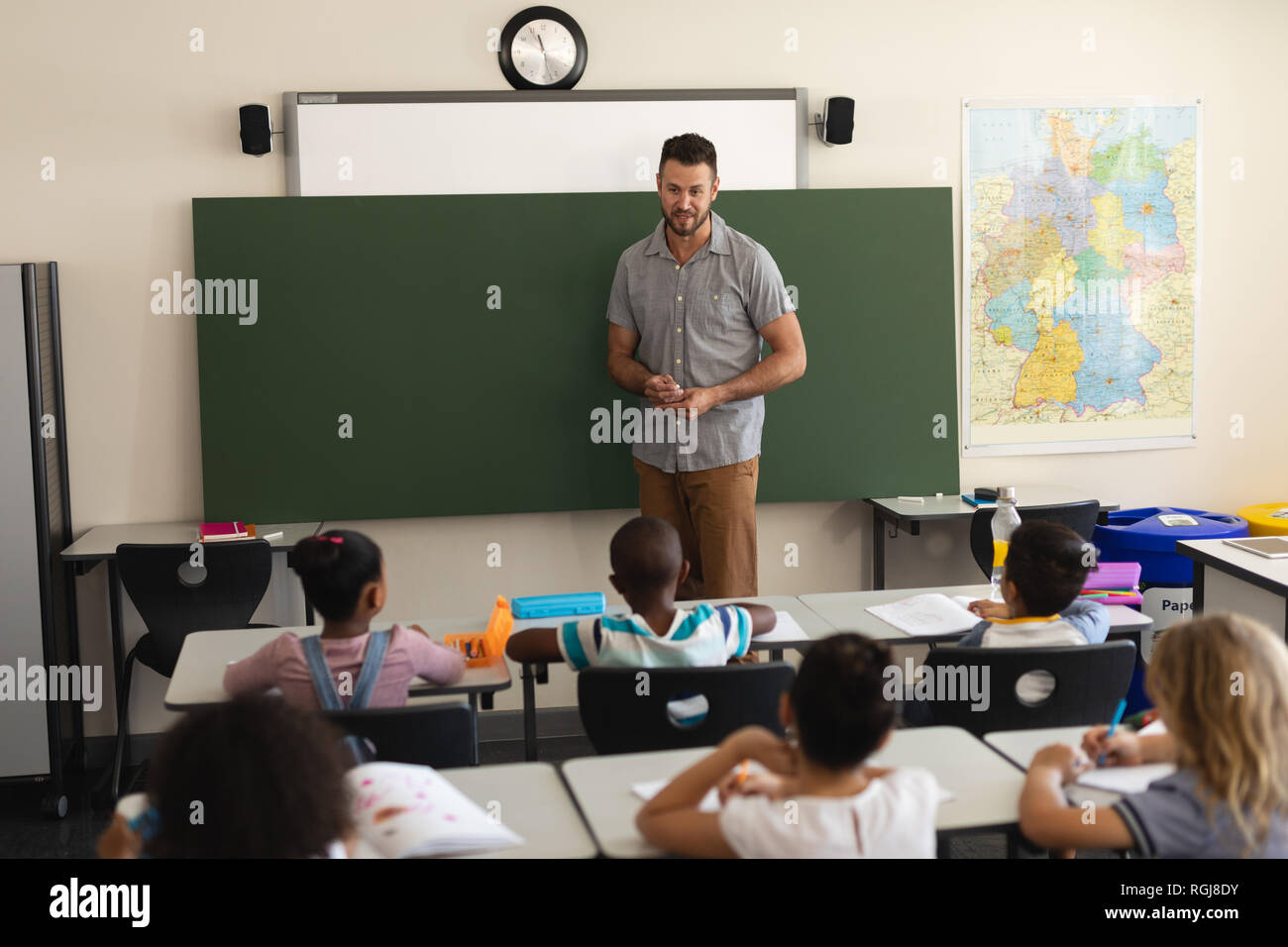Accelerate Learning with Primary Science Tuition Singapore for Young Minds
Accelerate Learning with Primary Science Tuition Singapore for Young Minds
Blog Article
A Comprehensive Overview to the Various Discovering Methods in Primary Scientific Research Instruction
The expedition of diverse discovering approaches in primary science guideline presents a possibility for educators to improve pupil engagement and comprehension significantly. By checking out hands-on knowing strategies, inquiry-based approaches, and collaborative methods, we can recognize effective methods that cater to different finding out designs. In addition, the integration of technology and distinguished direction plays a critical duty in fostering a comprehensive environment. However, the question remains: how can these methods be effectively executed in the classroom to maximize their impact? The answer hinges on a closer analysis of each strategy and its effects for training science.

Hands-On Understanding Techniques
Hands-on discovering strategies play a pivotal function in key science direction, involving trainees in energetic exploration and testing. These methods enable learners to engage directly with products and phenomena, cultivating a deeper understanding of clinical principles. By using manipulatives, designs, and real-life experiments, instructors develop a setting where students can observe, hypothesize, and evaluate their concepts.
Such strategies not just enhance comprehension however likewise cultivate critical thinking and problem-solving skills. When pupils take part in activities like building basic equipments, planting seeds, or conducting chain reactions, they are encouraged to ask questions and seek solutions via their very own monitorings. This experiential technique assists to demystify complicated scientific principles, making them more accessible and relatable.
In addition, hands-on understanding advertises cooperation amongst peers, as trainees commonly operate in teams to perform experiments or share searchings for. This team effort not only enriches their understanding experience yet likewise develops crucial social abilities. Eventually, integrating hands-on strategies in main science direction promotes a lifelong love of learning and inquisitiveness regarding the natural globe, laying a solid foundation for future scholastic quests in scientific research and beyond.
Inquiry-Based Discovering
Inquiry-based discovering is an educational technique that urges pupils to ask concerns, investigate phenomena, and construct their very own understanding of clinical ideas. This technique moves the emphasis from conventional teacher-led instruction to an extra student-centered experience, where learners take the campaign in their academic journey. By promoting curiosity, inquiry-based discovering advertises deeper interaction with the product, allowing trainees to discover topics in a significant context.
In technique, this method usually involves hands-on experiments, observations, and essential thinking activities that line up very closely with the scientific method. Trainees are urged to create hypotheses, design investigations, and examine information, which cultivates vital abilities such as analytical and problem-solving reasoning. The function of the instructor in this structure is to facilitate exploration, directing trainees with the questions procedure while urging independent idea and collaboration.
Furthermore, inquiry-based knowing nurtures a sense of ownership over the discovering procedure, encouraging pupils to seek expertise proactively. This approach not just boosts understanding of clinical principles yet additionally cultivates a long-lasting love for learning, equipping students with the skills necessary to navigate a progressively complicated world.
Collaborative Knowing Approaches
Collective knowing methods empower students to involve in significant communications with peers, promoting a shared duty for their instructional results. In primary scientific research instruction, these strategies urge learners to collaborate to explore clinical ideas, solve troubles, and conduct experiments (primary science tuition Singapore). By joining see here now team activities, trainees can leverage varied perspectives, permitting for richer understanding and retention of scientific expertise
One secret facet of collective learning is the focus on communication skills. Pupils need to articulate their ideas, listen proactively to others, and negotiate concepts, every one of which are vital competencies in both scholastic and real-world contexts. This social communication not just improves look at this site their understanding of clinical principles however additionally promotes synergy and conflict resolution abilities.
When pupils see the worth of their payments within a team, they are much more likely to take ownership of their learning journey. Overall, incorporating collaborative learning strategies in key scientific research guideline grows a dynamic knowing environment that prepares students for future academic and social obstacles.
Modern Technology Assimilation in Scientific Research
The combination of technology in primary scientific research guideline improves discovering experiences by providing cutting-edge devices and resources that support numerous mentor methods, including collaborative understanding - primary science tuition Singapore. The usage of digital platforms, simulations, and interactive applications allows pupils to involve deeply with scientific concepts, facilitating an extra hands-on strategy to discovering
Virtual laboratories, for circumstances, allow learners to perform experiments securely and efficiently, advertising inquiry-based discovering. These tools can imitate real-world clinical scenarios, permitting trainees to visualize intricate processes that would certainly be tough to replicate in a typical classroom setting. Innovation fosters interaction and collaboration amongst students, as they can share searchings for and function together on tasks through on-line platforms.
In addition, multimedia presentations and instructional videos can improve lessons by accommodating varied knowing designs, making abstract concepts a lot more accessible. Data evaluation devices likewise encourage trainees to accumulate and interpret scientific information, reinforcing critical believing abilities. Overall, the critical incorporation of innovation in primary science guideline not only enhances interaction yet also prepares trainees for a highly advanced culture, outfitting them with vital abilities for future check clinical undertakings.
Set Apart Instruction Techniques
Distinguished direction methods are crucial for dealing with the diverse needs of learners in main science education. These approaches allow instructors to customize their training methods to fit varying abilities, interests, and learning styles within the class. By utilizing set apart guideline, instructors can produce an inclusive environment that cultivates involvement and improves understanding of scientific concepts.
One effective technique is to utilize versatile grouping, which allows pupils to work together with peers at similar ability levels or with differing viewpoints. This technique encourages peer learning and advertises important thinking. In addition, using choices in jobs can equip students, permitting them to select tasks that resonate with their interests while still satisfying curricular objectives.
In addition, integrating tiered assignments is one more valuable strategy. Deliberately jobs with varying degrees of complexity, instructors can guarantee that all pupils are properly tested, despite their effectiveness. Using formative evaluations to gauge recognizing further allows teachers to change their educational methods dynamically, making certain that each learner obtains the support they require.
Ultimately, carrying out differentiated direction strategies in main scientific research education not just enhances trainee understanding outcomes however also cultivates an enthusiasm for scientific research, preparing students for future scholastic searches.

Conclusion
In recap, effective main scientific research direction demands a multifaceted technique that encompasses hands-on discovering, inquiry-based methods, and collective strategies. The integration of innovation and set apart instruction additionally provides to diverse knowing designs, cultivating an environment favorable to expedition and crucial thinking.
The expedition of varied learning techniques in main scientific research guideline presents a chance for teachers to boost pupil engagement and comprehension substantially.Hands-on understanding strategies play a pivotal role in main science direction, involving pupils in energetic expedition and trial and error.Inquiry-based understanding is an instructional approach that encourages students to ask questions, examine phenomena, and construct their own understanding of scientific concepts.Collective knowing techniques equip trainees to engage in meaningful interactions with peers, fostering a shared responsibility for their educational outcomes. Overall, integrating collective discovering techniques in main science instruction cultivates a vibrant discovering atmosphere that prepares trainees for future academic and social obstacles.
Report this page